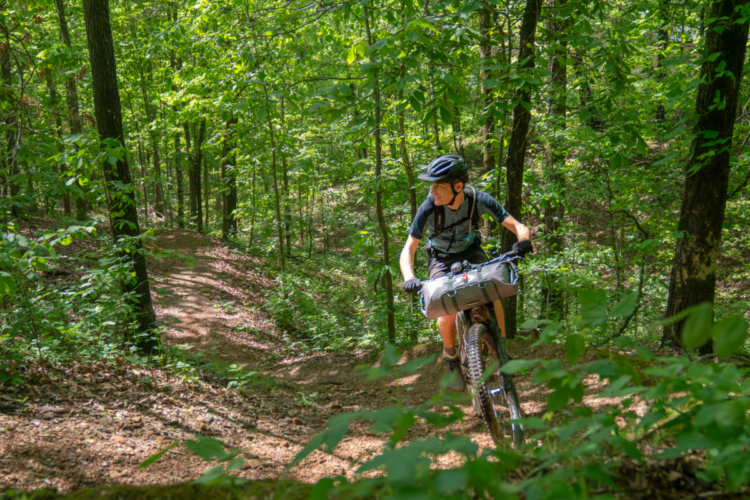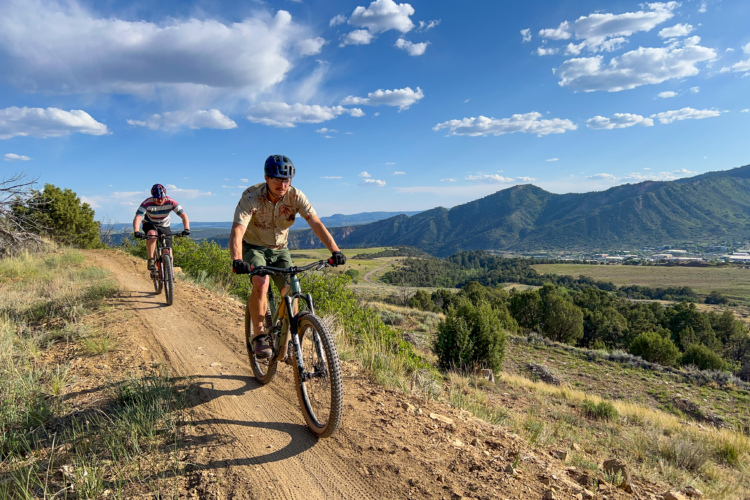
The topic of tire pressure inflated while chatting with some new riders the other day, and one of them mentioned running 27psi — when they remember to check. This particular athlete fell in love with trails over the summer as a new pandemic hobby, and she now rides a couple times per week. She also weighs 125lb, and that piqued my attention as to why she chose to run such high pressure.
“Someone at the bike shop told me to,” she said. While bike shops are often the best source of information for most things MTB-related, this was clearly a misspoke notion.
My friend asked if that number seemed accurate and how she could determine a more precise pressure for her weight and riding style. There are countless ways to find the ideal pressure, and the result is inarguably subjective. A starting point that’s always worked well for me is to use a formula I found on the Stan’s NoTubes website when they first started making tubeless sealant.

That formula is (rider weight in pounds divided by 7) – 1 for the front tire and the same formula +2 for the rear tire. In the case of my friend, that’s 125 LBS / 7 = 17.9psi. So she would want to run roughly 17psi under the bars and 20 beneath the saddle. This formula has always worked well for me, with small tweaks to accommodate terrain, temperatures, and other important variables.
Following the above computation, the best way to determine your optimal tire pressure is to go ride. You may hit the trail and find that the front tire is too low for your body position and the dirt surface. If you’re rolling your version of fast down a favorite descent and you hear the rim strike more than once against rocks and roots you may want to add some air. Conversely, if the rim never bottoms out at max speed and you’re having trouble maintaining traction, you may want to lose 1-2psi and reassess. If you have appropriate tread for the trail surface and your riding style, the right pressure will do much of the work to help you achieve maximum grip and go faster.

Certain trails and weather conditions call for different tire pressures. A lot of folks like to drop their tire pressure slightly to achieve more grip on muddy trails and raise it for fast rocky tracks or jump sessions. The difference between those condition-specific pressures is often 1-3 PSI, and it’s important to know how much air is inside the rubber so you can adjust it in the right direction. Loads of riders check their pressure with the palm of their hand, using feel to determine how much air is inside. I tried this for several years, and when I actually checked the pressure with a gauge it varied by 3-5psi despite feeling the same as the prior pump. That discrepancy was too wide for me, and I now use a digital gauge to dial in the numbers before every ride. It adds 1-2 seconds to the ride-prep process, affords me some mental security on the rocks, and provides the ability to more accurately test tires and wheels.
Looking for a mountain bike tire recommendation? These are our editors’ favorite MTB tires.
Speaking of variables, there are a lot of things that affect tire pressure, and many more that are affected by the amount of wind inside that C-shaped rubber. Tire pressure changes with temperature and elevation, and you may need to adjust the numbers depending on where and when you’re riding. The pressure amount will affect the way the tire deforms over obstacles, in turns, and through compressions, how it grips, overall rolling resistance, bump absorption, puncture and rim protection, and the size of the traction patch, among other factors. Tire pressure is one of the most important pieces of pre-ride bike setup, and it’s worth playing around with different numbers to find what feels best for you.
Additional resources
Some readers have found this SRAM calculator to be helpful for finding the right tire pressure. Even though the form says it’s for Zipp wheels the results are generally applicable to other wheels too. This calculation is one of the most detailed we’ve seen, taking tire casing, rim width, and even trail conditions into account and offering separate recommendations for front and rear tire pressure. Based on our tests the SRAM tool recommends dropping tire pressure by about 1psi in wet conditions.

MTB tire pressure survey*
Terrain, trail conditions, equipment, and riding style all play a role in choosing the right mountain bike tire pressure. But for everyday rides, or rides where we’re not sure what to expect, most of us have a go-to amount of pressure we prefer. What’s yours?
* Survey results will be shown after you’ve submitted your vote.











43 Comments
Jan 5, 2022
This formula might be an okay starting point, but there are a lot of other factors involved to make it this simple.
Also, if riding pump tracks or jumps, Sam Pilgrim says to run much higher pressure and you will have better smoother take offs because the tire won't flex and cause you to go off track when pumping hard. He is right. It's why I run 60 PSI on my DJ Bike.
Jan 6, 2022
Jan 5, 2022
May 24, 2020
May 30, 2020
May 27, 2020
May 24, 2020
May 28, 2020
Jan 6, 2022
Jan 6, 2022
Jan 6, 2022
May 27, 2020
XC/Trail Bikes - 21F/25R (most conditions)
Plus bike- 11F/15R
Fat Bike - trail/conditions dependent but typically well below 10PSI
May 30, 2020
@165, I run 11-14 with a 15 psi max psi. 27.5 x 3.hellyeah!!
May 29, 2020
May 28, 2020
May 28, 2020
May 27, 2020
Jan 8, 2022
Dec 3, 2022
Jun 4, 2020
Jun 4, 2020
Jan 8, 2022
Formaulas are dandy for crash test dummies.
May 28, 2020
May 29, 2020
Jan 5, 2022
Again, the formula seems to work well and the pressures given are in the range I ride for my weight. But like the article says those pressures are starting points and you should play around with them to find what feels right on the trails.
Jan 5, 2022
Perhaps it's time for an update to the formula. I propose weight divided by 8, or maybe 8.5?
May 31, 2020
May 25, 2020
two seconds spurt with my garage air compressor .
squeeze again .
start riding
May 26, 2020
May 29, 2020
May 30, 2020
Jan 11, 2022
May 29, 2020
May 29, 2020
Q-Tubes SL 26 x 2.7's fit perfectly and eliminate the tire swap drama.
May 29, 2020
Having seen Danny Mcaskill try to destroy the rims on his santa cruz, I no longer worry about my rims, I just keep enough pressure to avoid pinch flats.
Jul 12, 2020
May 26, 2020
Jun 15, 2022
Jan 8, 2022
Temp effects pressure based on the difference in degrees Kelvin For example, if you pump your tires to 25 psi at 60F you will have about 8% higher pressure at 100F or about 27psi at the heat of the day. The one time to worry would be roadies on black tarmac which can get considerably hotter than 100(especially if using rim brakes), but MTBers need not clutter their minds with such worry.
Jan 7, 2022
Mar 10, 2022
Jan 5, 2022
May 21, 2023